|
Vladivostok
Vladivostok ( ; , ) is the largest city and the administrative center of Primorsky Krai and the capital of the Far Eastern Federal District of Russia. It is located around the Zolotoy Rog, Golden Horn Bay on the Sea of Japan, covering an area of , with a population of 603,519 residents Vladivostok is the second-largest city in the Far Eastern Federal District, as well as the Russian Far East, after Khabarovsk. It is located approximately from the China–Russia border and from the North Korea–Russia border. What is now Vladivostok was part of Outer Manchuria. Shortly after the signing of the Treaty of Aigun between Qing China and the Russian Empire and affirmed by the Convention of Peking – from which it is also known as the Amur Annexation – the city was founded as a Russian military outpost on July 2, 1860. In 1872, the main Russian naval base on the Pacific Ocean was transferred to the city, stimulating its growth. In 1914 the city experienced rapid growth economical ... [...More Info...] [...Related Items...] OR: [Wikipedia] [Google] [Baidu] |
Allied Intervention In The Russian Civil War
The Allied intervention in the Russian Civil War consisted of a series of multi-national military expeditions that began in 1918. The initial impetus behind the interventions was to secure munitions and supply depots from falling into the German Empire's hands, particularly after the Bolsheviks signed the Treaty of Brest-Litovsk, and to rescue the Allied forces that had become trapped within Russia after the 1917 October Revolution. After the Armistice of 11 November 1918, the Allied plan changed to helping the White movement, White forces in the Russian Civil War. After the Whites collapsed, the Allies withdrew their forces from Russia by 1925. Allied troops landed in Arkhangelsk (the North Russia intervention of 1918–1919) and in Vladivostok (as part of the Siberian intervention of 1918–1922). The British also British campaign in the Baltic (1918–1919), intervened in the Baltic theatre (1918–1919) and Dunsterforce, in the Caucasus (1917–1919). French-led Allied force ... [...More Info...] [...Related Items...] OR: [Wikipedia] [Google] [Baidu] |
Primorsky Krai
Primorsky Krai, informally known as Primorye, is a federal subjects of Russia, federal subject (a krais of Russia, krai) of Russia, part of the Far Eastern Federal District in the Russian Far East. The types of inhabited localities in Russia, city of Vladivostok on the southern coast of the krai is its administrative center, and the second largest city in the Russian Far East, behind Khabarovsk in the neighbouring Khabarovsk Krai. Primorsky Krai has the largest economy among the federal subjects in the Russian Far East, and a list of federal subjects of Russia by population, population of 1,845,165 as of the Russian Census (2021), 2021 Census. The krai has Russia's only North Korea–Russia border, border with North Korea, along the Tumen River in Khasansky District in the southwestern corner of the krai. Peter the Great Gulf, the largest gulf in the Sea of Japan, is on the south coast. The territory of the krai was historically part of Manchuria. It was Convention of Pek ... [...More Info...] [...Related Items...] OR: [Wikipedia] [Google] [Baidu] |
Japanese Intervention In Siberia
The of 1918–1922 was a dispatch of Japanese military forces to the Russian Maritime Provinces, as part of a larger effort by western powers and Japan to support White Russian forces against the Bolshevik Red Army during the Russian Civil War. The Japanese suffered 1,399 killed and another 1,717 deaths from disease. ''World War I: A Student Encyclopedia''. p.969. Japanese military forces occupied Russian cities (largest city Vladivostok) and towns in the province of Primorsky Krai between 1918 and 1922. Background On August 23, 1914, the Empire of Japan declared war on Germany, in part due to the Anglo-Japanese Alliance, and Japan became a member of the Entente powers. The Imperial Japanese Navy made a considerable contribution to the Allied war effort; however, the Imperial Japanese Army was more sympathetic to Germany, and aside from the seizure of Qingdao, resisted attempts to become involved in combat. The overthrow of Tsar Nicholas II and the establishment of a Bo ... [...More Info...] [...Related Items...] OR: [Wikipedia] [Google] [Baidu] |
Vladivostok Railway Station
Vladivostok railway station is a railway station in Vladivostok, Russia. It is the eastern terminus of the Trans-Siberian Railway. Also, Aeroexpress (Express Primorya) from this station to Vladivostok International Airport ( Knevichi Railway Station) are operated. History The author of the project, architect P.E. Bazilevsky,Лисовский В. Г. Архитектура России XVIII — начала XX века. Поиски национального стиля. — М.: Белый город, 2009. — С. 524—525. — 568 с. — (Энциклопедия мирового искусства). — . took part in laying the station building, laying the first stone of the structure on May 19 (31), 1891 in the presence of Tsarevich Nikolai Aleksandrovich, the future emperor Nicholas II. On November 2, 1893, a solemn consecration of the station took place, and a rail link along the route Vladivostok - Ussuriysk was opened. Initially, it was a stone building with an ... [...More Info...] [...Related Items...] OR: [Wikipedia] [Google] [Baidu] |
Russian Far East
The Russian Far East ( rus, Дальний Восток России, p=ˈdalʲnʲɪj vɐˈstok rɐˈsʲiɪ) is a region in North Asia. It is the easternmost part of Russia and the Asia, Asian continent, and is coextensive with the Far Eastern Federal District, which encompasses the area between Lake Baikal and the Pacific Ocean. The area's largest city is Khabarovsk, followed by Vladivostok. The region shares land borders with the countries of Mongolia, China, and North Korea to its south, as well as maritime boundary, maritime boundaries with Japan to its southeast, and with the United States along the Bering Strait to its northeast. Although the Russian Far East is often considered as a part of Siberia abroad, it has been historically categorized separately from Siberia in Russian regional schemes (and previously during the history of the Soviet Union, Soviet era when it was called the Soviet Far East). Terminology In Russia, the region is usually referred to as simply th ... [...More Info...] [...Related Items...] OR: [Wikipedia] [Google] [Baidu] |
Sea Of Japan
The Sea of Japan is the marginal sea between the Japanese archipelago, Sakhalin, the Korean Peninsula, and the mainland of the Russian Far East. The Japanese archipelago separates the sea from the Pacific Ocean. Like the Mediterranean Sea, it has almost no tides due to its nearly complete enclosure from the Pacific Ocean. This isolation also affects faunal diversity and salinity, both of which are lower than in the open ocean. The sea has no large islands, bays or capes. Its water balance is mostly determined by the inflow and outflow through the straits connecting it to the neighboring seas and the Pacific Ocean. Few rivers discharge into the sea and their total contribution to the water exchange is within 1%. The seawater has an elevated concentration of Oxygen saturation, dissolved oxygen that results in high biological productivity. Therefore, fishing is the dominant economic activity in the region. The intensity of shipments across the sea has been moderate owing to politi ... [...More Info...] [...Related Items...] OR: [Wikipedia] [Google] [Baidu] |
Russky Bridge
The Russky Bridge () is a cable-stayed bridge in Vladivostok, Primorsky Krai, Russia. The bridge connects the Russky Island and the Muravyov-Amursky Peninsula sections of the city across the Eastern Bosphorus strait, and with a central span of , it is the List of longest cable-stayed bridge spans, longest cable-stayed bridge in the world. The architect of the Russky Island Bridge is Vlydskinol Ptrov. The Russky Bridge was originally built to serve the APEC 2012, 2012 Asia-Pacific Economic Cooperation conference hosted at the Far Eastern Federal University campus on Russky Island. It was completed in July 2012 and opened by Prime Minister Dmitry Medvedev, and on September 3, 2012, the bridge was officially given its name. Overview The bridge to Russky Island is the world's longest cable-stayed bridge, with a -long central Span (engineering), span. The bridge also has the second-highest Tower, pylons after the Millau Viaduct and the longest cable stays. The design of the bri ... [...More Info...] [...Related Items...] OR: [Wikipedia] [Google] [Baidu] |
Khabarovsk
Khabarovsk ( ) is the largest city and the administrative centre of Khabarovsk Krai, Russia,Law #109 located from the China–Russia border, at the confluence of the Amur and Ussuri Rivers, about north of Vladivostok. As of the 2021 Russian census, it had a population of 617,441. It was known as ''Khabarovka'' until 1893. The city was the administrative center of the Far Eastern Federal District of Russia from 2002 until December 2018, when the status was given to Vladivostok. As is typical of the interior of the Russian Far East, Khabarovsk has an extreme climate with strong seasonal swings resulting in strong, cold winters and relatively hot and humid summers. History Earliest record Historical records indicate that a city was founded on the site in the eighth century. The Tungusic peoples are indigenous to the city's vicinity. The city was named ( zh, t= 伯力, p=Bólì, labels=no) in Chinese when it was part of the Chinese empire. During the Tang dynasty, Boli was th ... [...More Info...] [...Related Items...] OR: [Wikipedia] [Google] [Baidu] |
Far Eastern Federal District
The Far Eastern Federal District ( rus, Дальневосточный федеральный округ, p=dəlʲnʲɪvɐˈstot͡ɕnɨj fʲɪdʲɪˈralʲnɨj ˈokrʊk) is the largest and the least populated federal districts of Russia, federal district of Russia, with a population of around 7.9 million and an area of . The federal district within the North Asia as per the United Nations geoscheme, UN geoscheme and it is coextensive with the Russian Far East. History The Far Eastern Federal District was established on 13 May 2000 by President of Russia, President Vladimir Putin. It is currently governed by presidential envoy Yury Trutnev. In November 2018, Buryatia and Zabaykalsky Krai were added to the federal district. The seat of the Far Eastern Federal District was moved from Khabarovsk to Vladivostok in December 2018. On 15 July 2022, the first high-speed highway was opened in the Far Eastern Federal District. It united three federal highwaysA370 highway (Russia), Ussur ... [...More Info...] [...Related Items...] OR: [Wikipedia] [Google] [Baidu] |
Outer Manchuria
Outer Manchuria, sometimes called Russian Manchuria, refers to a region in Northeast Asia that is now part of the Russian Far East but historically formed part of Manchuria (until the mid-19th century). While Manchuria now more normatively refers to Northeast China, it originally included areas consisting of Priamurye between the left bank of Amur River and the Stanovoy Range to the north, and Primorskaya which covered the area in the right bank of both Ussuri River and the lower Amur River to the Pacific Coast. The region was ruled by a series of Chinese dynasties and the Mongol Empire, but control of the area was ceded to the Russian Empire by Qing China during the Amur Annexation in the 1858 Treaty of Aigun and 1860 Treaty of Peking, with the terms "Outer Manchuria" and "Russian Manchuria" arising after the Russian annexation. Prior to its annexation by Russia, Outer Manchuria was predominantly inhabited by various Tungusic peoples who were categorized by the Han Ch ... [...More Info...] [...Related Items...] OR: [Wikipedia] [Google] [Baidu] |
Zolotoy Bridge
The Zolotoy Bridge () is a cable-stayed bridge across the Zolotoy Rog (Golden Horn Bay) in Vladivostok, Russia. The Zolotoy Rog Bridge was one of two bridges, along with the Russky Island Bridge, built in preparation for the 2012 APEC summit. The bridge was commissioned by the city of Vladivostok in 2006. Construction of the bridge began on July 25, 2008, and the bridge was officially opened on August 11, 2012. It is considered the world's 14th longest cable-stayed bridge. This bridge over Golden Horn Bay made it possible to travel from the centre of Vladivostok to the remote Churkin Cape in only 5–10 minutes instead of the usual 1.5–2 hours. See also * Golden Bridge (other) *Russky Bridge The Russky Bridge () is a cable-stayed bridge in Vladivostok, Primorsky Krai, Russia. The bridge connects the Russky Island and the Muravyov-Amursky Peninsula sections of the city across the Eastern Bosphorus strait, and with a central span of ... * List of tallest bridg ... [...More Info...] [...Related Items...] OR: [Wikipedia] [Google] [Baidu] |







